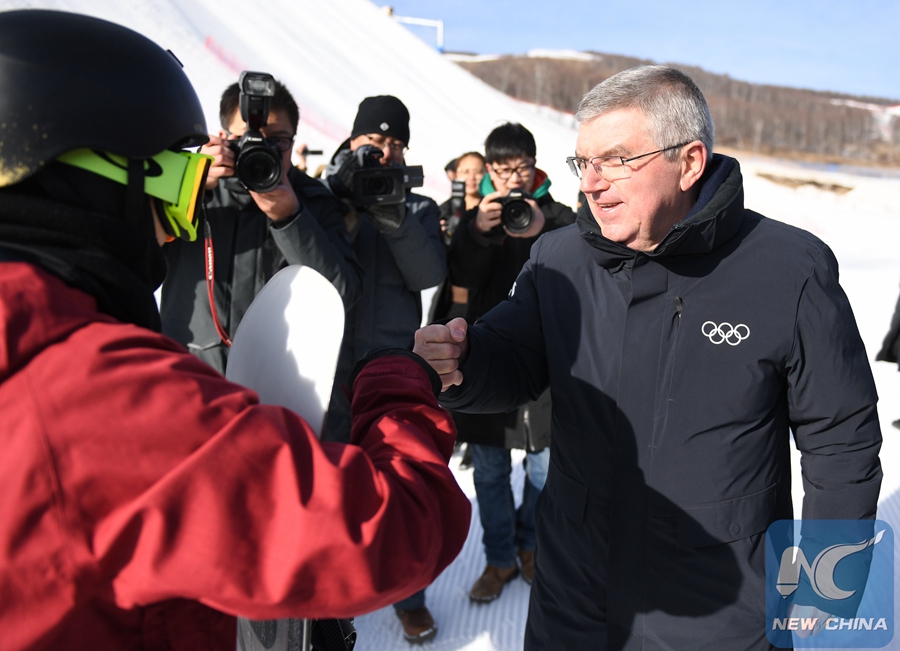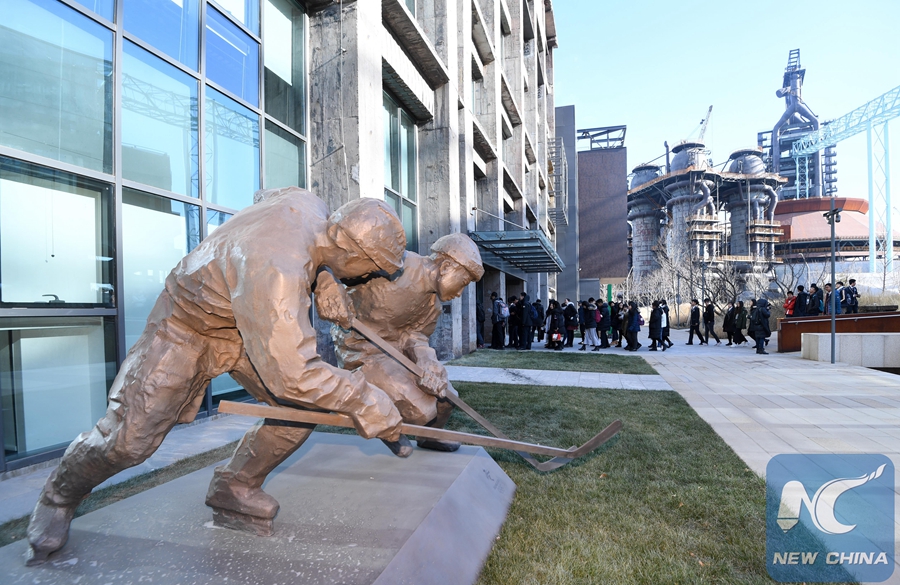
IOC president Thomas Bach inspected several of the 2022 Winter Games' venues in Zhangjiakou and Yanqing on Jan. 29. (Xinhua/Zhang Chenlin)
By Xinhua writers Song Meili and Spencer Musick
BEIJING, Feb. 3 (Xinhua) -- Just beside Beijing's National Tennis Center sits the National Speed Skating Hall for the Beijing Winter Olympics, now under construction, which is also known as the Ice Belt. The venue is planned to be finished and covered with ice for the first time by the end of the year.
The shape of the building is based on the free curving curtain wall of the National Speed Skating Hall, and also complements venues like the National Stadium "Bird's Nest" and the National Aquatic Center "Water Cube", both of which will also be reused for Beijing 2022.
The Ice Belt is just one of numerous Beijing Winter Olympic buildings that have set new benchmarks for the construction and utilization of Olympic venues, all integrated with Chinese cultural elements and design features.
SUMMER GAMES VENUES GIVEN NEW LIFE BY WINTER OLYMPICS
When the curtain rises in 2022, Beijing will become the first city to have held both Summer and Winter Olympic Games. Many legacy venues from Beijing 2008 will be transformed for the Winter Olympics.
Although Beijing 2008 is more than 10 years behind us, several 2008 Olympic Games venues are still landmark icons of this international megacity, noted for their stunning design features and architectural innovations.
Buildings like the National Stadium have achieved innovative breakthroughs in architectural history; factors like structure, shape, form, function and color schemes all underline their status as landmarks in both scientific and cultural terms.
Beijing 2008 was noted for its marvelous opening and closing ceremonies, and the Bird's Nest will continue this legacy by staging Beijing 2022's opening and closing events. The Bird's Nest has already started preparation and renovation work to guarantee a smooth transition to its key role for the 2022 Winter Olympics.
It is a similar story with the well-known Water Cube from 2008. It will be transformed into an Ice Cube through the addition of a movable and transferable ice rink to host the curling events for Beijing 2022.
The Water Cube will become the first-ever venue to achieve such an "ice-water conversion," according to Yang Qiyong, general manager of Beijing National Aquatics Center Limited.
In the Nationa Indoor Stadium, imitation ice glass renovated from the former glass curtain wall will introduce natural lighting inside the venue to reduce electricity consumption.
Another one of the symbolic Beijing Summer Olympic venues, the Wukesong Arena, had already created facilities to make it a suitable venue for ice sports at the beginning of its original construction. After the Beijing 2008 basketball competition was held here, figure skating and ice hockey competitions have been held many times over the intervening decade.
The transformation of these symbolic 2008 structures constitutes a uniquely Chinese miracle for the repurposing of Olympic venues. All of them will leave an indelible mark on Olympic history.
SCIENCE AND CHINESE CULTURE INTEGRATED IN NEW VENUES
Scientific features are prominent in the construction of Beijing Winter Olympic venues, and Chinese elements are seamlessly integrated as well. Consideration has also been given to sustainability, with potential uses after the competition being taken into account even in the earliest stages of planning and execution.
According to the Beijing 2022 Organizing Committee, the Winter Olympics will incorporate 26 competition and non-competition venues in total. 13 venues planned in the Beijing zone will host all ice events including skating, hockey, curling and select snow competitions like big air.
The Yanqing zone located on Xiaohaituo mountain in northern outskirt of Beijing will have five venues for alpine skiing, sleighing and luge. The Zhangjiakou zone in Hebei province will play host to eight venues including freestyle skiing, snowboarding, biathlon, ski jumping and cross-country skiing.
Because of the special demands of ice and snow sports, the venues for the Winter Olympic Games have had to reckon with a series of technical challenges.
The National Speed Skating Hall, of which the principal venue covers around 80,000 square meters, was designed with a nod to the combination of speed and skill on the ice that the sport requires. It features a ribbon-like design circling along the curving outer wall, which gives the impression of the trails left by speed skating athletes on the ice.
"The trails morph into 22 ice ribbons, symbolizing the Beijing 2022 Winter Olympic Games. These glittering ice ribbons are made of curved glass," according to Zheng Fang, architect with the Beijing Institute of Architectural Design.
Vice-president of Beijing State-owned Assets Management Limited, Wu Xiaonan says, "The ice ribbon was designed to be the biggest scale saddle-shaped cable network roof with a bidirectional single layer in the world. The whole roof system contains several innovative technical features."
The first difficulty met in the construction of the ice ribbon was its 200-meter long and 130-meter wide roof span. This irregular saddle-shaped roof caused increased difficulties during construction. In order to solve the problem, the National Speed Skating Hall will be built into the world's largest gym with a single-layer cable network.
The finished ice ribbon has broken the Asian record with its 12,000 square meters ice rink. The ice ribbon was designed to satisfy not only the demands of ice sporting events themselves, but also in order to be suitable for repurposing and reuse in the future.
In the Yanqing zone, the National Sliding Center is located on the southern slope of the mountain. Its construction is the result of a great deal of previous research and development into natural and artificial topography, climate protection systems like sun-blocking roofs, and optimum track shapes. These prevent the track surface from falling victim to climate instability, all the while reducing energy consumption.
The planned exteriors of the Zhangjiakou zone venues are highlighted with Chinese elements. The National Ski Jumping Center will host competitions in Ski Jumping and Nordic Combined. The 'S-type' curve resembles the shape of 'ruyi,' a traditional Chinese ornamental object for luck. Here, it's been given the nickname snow 'ruyi.' On the top of the hills is a ring of public space designed for athletes and technical officials during the Games, and will be turned into restaurants and conference halls after the Olympics.
In the Zhangjiakou zone, the venues have been built with an eye toward their use after the curtain falls on Beijing 2022. Snow event tracks and venues will be preserved to ensure that they can be reused in the future, and tourism will be developed around the area so as to make it a holiday and leisure destination in the future. All the while, these spaces will remain fit to hold future international and domestic sports events.

The Shougang Industry Park on Jan. 2. (Xinhua/Chen Yehua)
Moving back to Beijing city proper, the Shougang Industry Park, where the Beijing Organizing Committee's Office for the 2022 Olympics is located, has been completely transformed. Every building has been renovated and repurposed. The jumping platform for Big Air will be hosted in Shougang, as well as the winter sports training center of China's General Administration of Sport.
The International Olympic Committee calls the Shougang Industry Park a role model for its Olympic vision. Time and time again, IOC officials have noted that the Beijing Winter Olympics encapsulates the ways in which an Olympiad can boost the long-term development of a country's economy and society.
Similarly, the Beijing Winter Olympic Coordination Commission believes that Beijing 2022 has made the best use of existing Beijing 2008 legacy venues, while at the same time assuring that long-lasting and sustainable infrastructure will pay social, economic, and cultural dividends for generations to come.
Beijing, its surrounding province of Hebei, and all provinces and regions in China will reap the long-term benefits of these achievements. Beijing 2022 has set a new benchmark for future Olympic editions that makes the upcoming installment of the Winter Games truly greater than the sum of its individual parts.
(Wang Yong, Ji Ye, Bai Lin also contributed to this story.)

